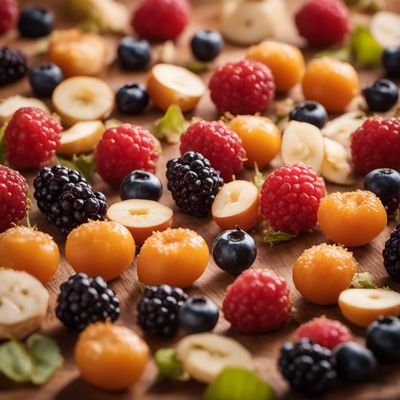
Ingredient
Red elderberries
The Vibrant Gems of the Forest
Red elderberries are small, round berries that grow in clusters on the red elder tree. They have a tart and slightly bitter taste, similar to cranberries, and their vibrant red color adds visual appeal to dishes. The berries have a soft and juicy texture, making them perfect for jams, jellies, and desserts.
Origins and history
Red elderberries have a long history of use in traditional medicine and culinary practices. Native to North America, Europe, and parts of Asia, red elderberries have been used by indigenous cultures for their medicinal properties and as a food source. They are also known for their association with folklore and mythology.
Nutritional information
Red elderberries are a good source of vitamin C and antioxidants. They also contain small amounts of vitamins A and B6, as well as minerals like potassium and calcium. However, it's important to note that red elderberries should not be consumed raw as they contain toxic compounds that can cause nausea and other symptoms.
Allergens
Red elderberries may cause allergic reactions in some individuals, particularly those with sensitivities to berries or related fruits. It is advisable to exercise caution and consult a healthcare professional if you have any concerns or known allergies.
How to select
When selecting red elderberries, look for plump, firm berries that are fully ripe and have a deep red color. Avoid berries that are unripe, green, or have any signs of mold or damage. It's also important to note that red elderberries should not be consumed raw and must be cooked before use to remove any toxic compounds.
Storage recommendations
To prolong the freshness of red elderberries, store them in airtight containers or sealed bags in the refrigerator. They can also be frozen for longer-term storage. Use them within a few days for the best flavor and texture.
How to produce
Red elderberries can be produced by growing red elder trees from seeds or cuttings. They thrive in temperate climates and can be cultivated in home gardens or larger orchards. However, it's important to handle red elderberries with caution and ensure they are properly cooked before consumption.
Preparation tips
Red elderberries can be used in a variety of culinary applications, including making jams, jellies, syrups, and sauces. They can also be incorporated into baked goods, such as pies, tarts, and muffins, or used to infuse beverages like teas and cocktails.
Culinary uses
Red elderberries are commonly used in traditional European dishes, such as elderberry pie, elderberry wine, and elderberry cordial. They are also popular in North American cuisine, where they are used in jams, sauces, and desserts.
Availability
Red elderberries are commonly found in temperate regions of North America, Europe, and parts of Asia. They can be foraged in the wild or purchased from specialty food stores or farmers markets.
More ingredients from this category » Browse all

Elderberries
The Power of Elderberries

Sorb fruits
The Sweet and Tangy Delights of Sorb Fruits

Bayberries
The Hidden Gems of the Forest

Silverberries
The Shimmering Gems of the Culinary World

Dwarf elderberries
The Tiny Powerhouse: Exploring the World of Dwarf Elderberries

Buffalo berries
The Tangy Delight of Buffalo Berries

Midland hawberries
The Hidden Gems of Midland: Exploring the Delights of Hawberries

Che berries
The Exotic Delight: Che Berries

Hawberries
The Vibrant Delight: Exploring the World of Hawberries

Riberries
The Vibrant Delight

Phalsa fruits
The Exotic Jewel of Summer: Phalsa Fruits

Saskatoons
The Sweet Berry of the Prairies